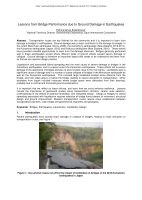Bridges

- Publication no: ABC2017-113-17
- Published: 26 April 2017
- PDF (free) Download
Transportation routes are key lifelines for the community and it is important to learn from damage to bridges in earthquakes. Ground damage was a major contributor to the damage to bridges, in the recent Wenchuan earthquake (China, 2008), the Canterbury earthquakes (New Zealand, 2010-2011), the Kumamoto earthquakes (Japan, 2016) and Kaikoura earthquake (New Zealand, 2016). These events have provided valuable opportunities to learn from the damage observed. Bridges generally performed well in these earthquakes except where different types of ground effects caused severe damage or collapse. Ground damage is therefore an important aspect that needs to be understood and leant from, so that we can improve design practice.
Liquefaction and associated lateral spreading was the main cause of severe damage to bridges in the Canterbury earthquakes, and to a lesser extent the Kumamoto earthquakes. These effects led to severe damage to the abutments of bridges and also to piers located close to the river banks. Landslides were a significant cause of damage and in a number of cases collapse of bridges in the Wenchuan earthquake as well as the Kumamoto earthquakes. This included large landslides located some distance from the bridge, and rock slides above or below the bridge, leading to severe disruption to transportation. Other examples from Japan included instances where bridge spans were dislocated from their bearings, probably due to vertical and horizontal ground accelerations.
It is important that we reflect on these failures, and learn how we could enhance resilience. Lessons include the importance of geohazard studies along transportation corridors, careful route selection, understanding of the effects of potential landslides, and integrated design. Design of bridges for lateral spreading associated with liquefaction requires selection of bridge forms tolerant of movement, structural design and ground improvement. Resilient transportation routes require close collaboration between transportation planners, road, bridge and geotechnical engineers and geologists.
